LAWS20009 - Employment Law Assignment: Wrongful Dismissal
VerifiedAdded on 2023/04/07
|7
|1406
|197
Homework Assignment
AI Summary
This assignment analyzes a wrongful dismissal case based on a client interview, providing a legal opinion supported by case law. The student addresses key issues such as termination without cause, notice periods, and the application of legal principles from cases like Bardal, Cronk, and Michela. The analysis considers factors such as length of service, age, and the availability of comparable employment. The assignment concludes that the employee has a strong case for wrongful dismissal, potentially entitling them to twelve months' notice or equivalent payment, and that the case is suitable for small claims court. The student references relevant legal principles and case law to support their conclusions.
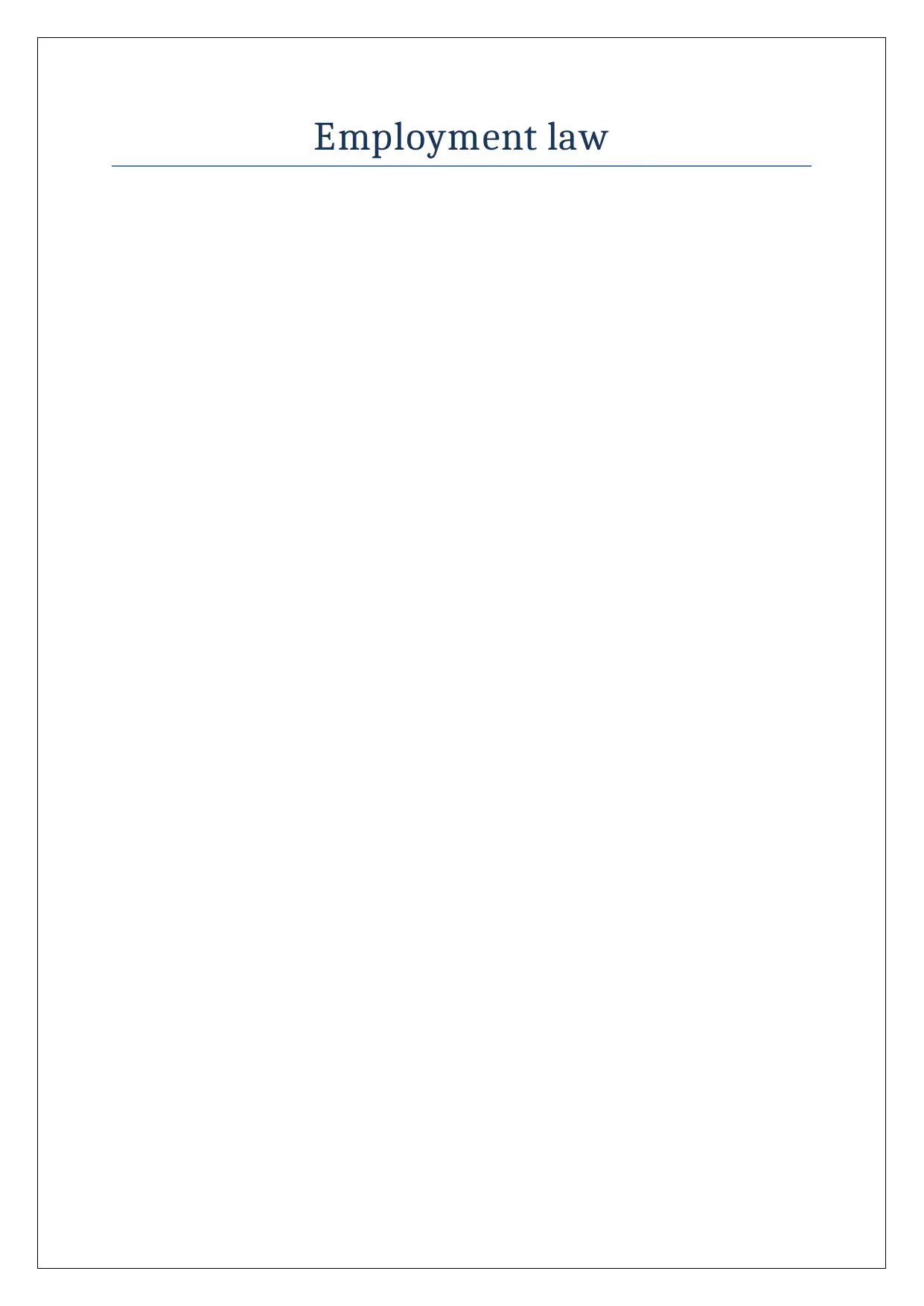
Employment law
Paraphrase This Document
Need a fresh take? Get an instant paraphrase of this document with our AI Paraphraser
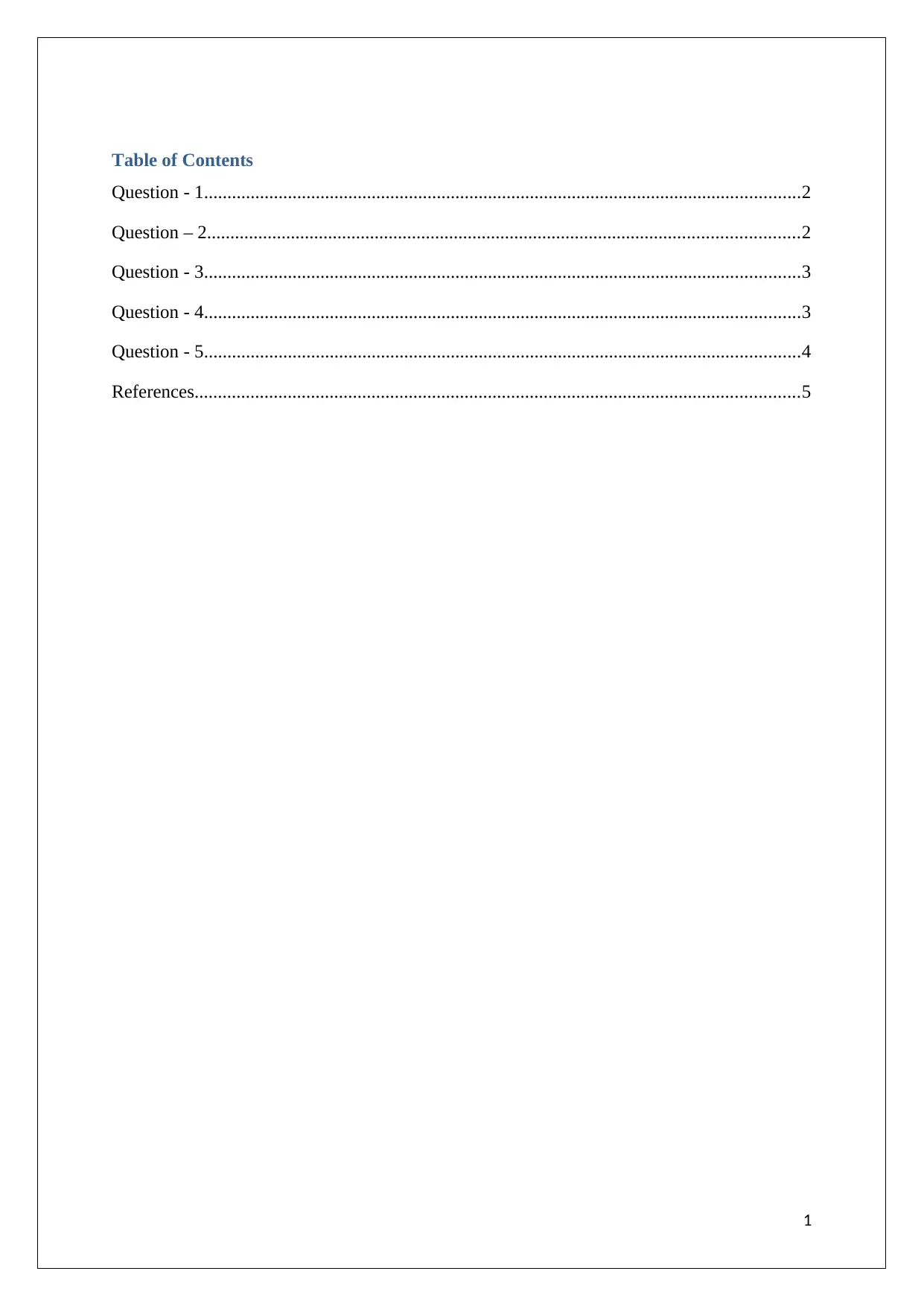
Table of Contents
Question - 1................................................................................................................................2
Question – 2...............................................................................................................................2
Question - 3................................................................................................................................3
Question - 4................................................................................................................................3
Question - 5................................................................................................................................4
References..................................................................................................................................5
1
Question - 1................................................................................................................................2
Question – 2...............................................................................................................................2
Question - 3................................................................................................................................3
Question - 4................................................................................................................................3
Question - 5................................................................................................................................4
References..................................................................................................................................5
1
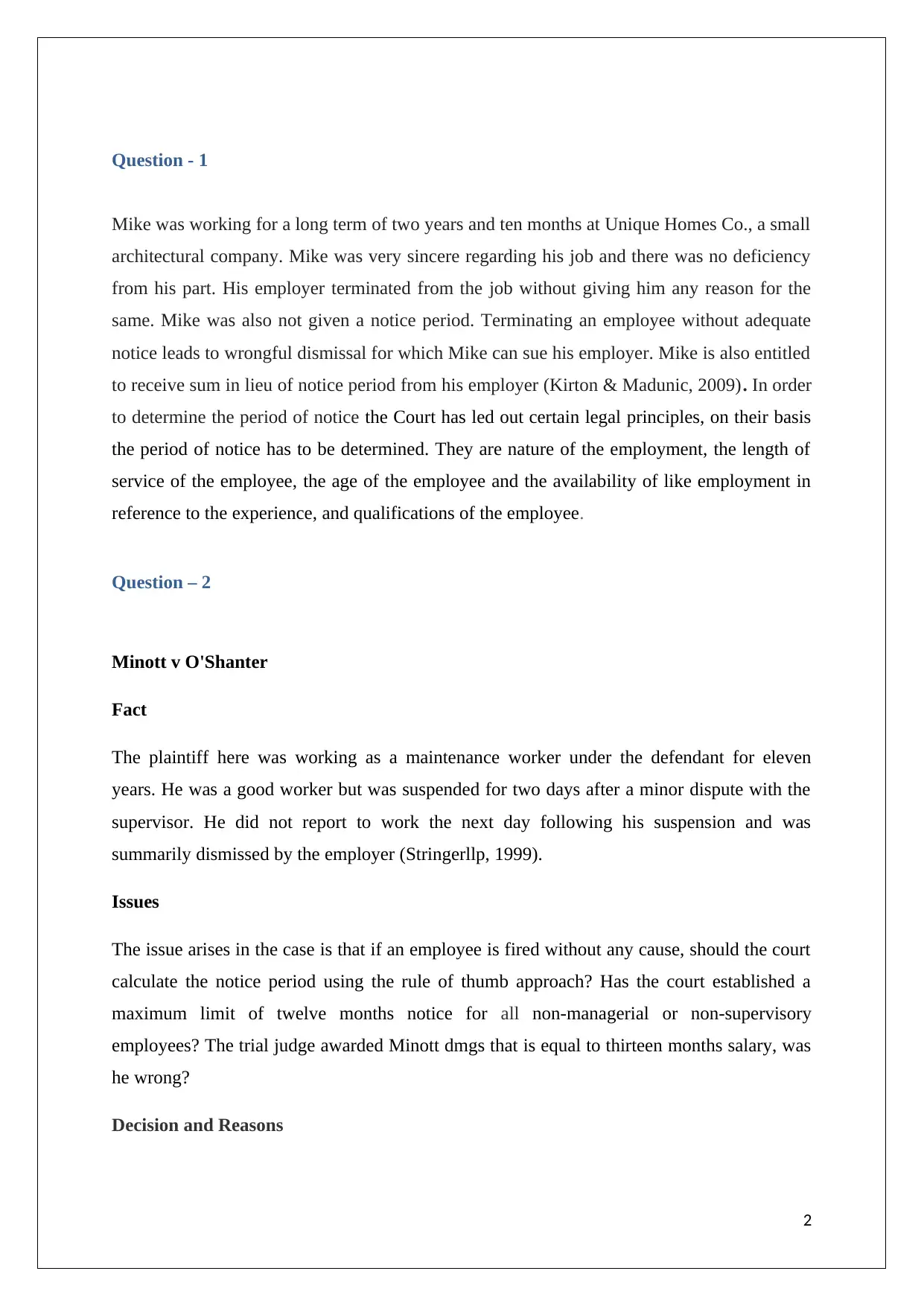
Question - 1
Mike was working for a long term of two years and ten months at Unique Homes Co., a small
architectural company. Mike was very sincere regarding his job and there was no deficiency
from his part. His employer terminated from the job without giving him any reason for the
same. Mike was also not given a notice period. Terminating an employee without adequate
notice leads to wrongful dismissal for which Mike can sue his employer. Mike is also entitled
to receive sum in lieu of notice period from his employer (Kirton & Madunic, 2009). In order
to determine the period of notice the Court has led out certain legal principles, on their basis
the period of notice has to be determined. They are nature of the employment, the length of
service of the employee, the age of the employee and the availability of like employment in
reference to the experience, and qualifications of the employee.
Question – 2
Minott v O'Shanter
Fact
The plaintiff here was working as a maintenance worker under the defendant for eleven
years. He was a good worker but was suspended for two days after a minor dispute with the
supervisor. He did not report to work the next day following his suspension and was
summarily dismissed by the employer (Stringerllp, 1999).
Issues
The issue arises in the case is that if an employee is fired without any cause, should the court
calculate the notice period using the rule of thumb approach? Has the court established a
maximum limit of twelve months notice for all non-managerial or non-supervisory
employees? The trial judge awarded Minott dmgs that is equal to thirteen months salary, was
he wrong?
Decision and Reasons
2
Mike was working for a long term of two years and ten months at Unique Homes Co., a small
architectural company. Mike was very sincere regarding his job and there was no deficiency
from his part. His employer terminated from the job without giving him any reason for the
same. Mike was also not given a notice period. Terminating an employee without adequate
notice leads to wrongful dismissal for which Mike can sue his employer. Mike is also entitled
to receive sum in lieu of notice period from his employer (Kirton & Madunic, 2009). In order
to determine the period of notice the Court has led out certain legal principles, on their basis
the period of notice has to be determined. They are nature of the employment, the length of
service of the employee, the age of the employee and the availability of like employment in
reference to the experience, and qualifications of the employee.
Question – 2
Minott v O'Shanter
Fact
The plaintiff here was working as a maintenance worker under the defendant for eleven
years. He was a good worker but was suspended for two days after a minor dispute with the
supervisor. He did not report to work the next day following his suspension and was
summarily dismissed by the employer (Stringerllp, 1999).
Issues
The issue arises in the case is that if an employee is fired without any cause, should the court
calculate the notice period using the rule of thumb approach? Has the court established a
maximum limit of twelve months notice for all non-managerial or non-supervisory
employees? The trial judge awarded Minott dmgs that is equal to thirteen months salary, was
he wrong?
Decision and Reasons
2
⊘ This is a preview!⊘
Do you want full access?
Subscribe today to unlock all pages.

Trusted by 1+ million students worldwide

It was decided by the court that there is no such rule of providing a notice period of twelve
months for all the non-managerial or non-supervisory employees. While deciding any case
weight should be given on relevant factors rather than the rule of thumb approach (England,
Wood & Christie, 2009).
Summerfield v. Staples Canada Inc
Fact
The Plaintiff Michelle Summerfield had worked for Staples as an account manager and was
terminated without any cause on 2015. She claimed that she ought to receive nine months
salary as compensation in lieu of the notice period. She seeks a summary judgment from the
court (Hughesamys, 2016).
Issues
The employer had to prove that she has not searched for any new comparable jobs within the
employee’s specific skills and abilities.
Decision and Reasons
It was held that immediately upon termination reasonable efforts to be made for searching
comparable employment. Failing to do so can reduce package one is entitled to receive.
Question - 3
The case of Michela v. St. Thomas of Villanova Catholic School, is relevant and applicable to
Mike’s matter and binding in Ontario.
a)Facts
The plaintiff Michela was terminated from her job at a private school as the school’s revenue
for that year was lower than expected. The plaintiff sued her employer for wrongful
dismissal.
3
months for all the non-managerial or non-supervisory employees. While deciding any case
weight should be given on relevant factors rather than the rule of thumb approach (England,
Wood & Christie, 2009).
Summerfield v. Staples Canada Inc
Fact
The Plaintiff Michelle Summerfield had worked for Staples as an account manager and was
terminated without any cause on 2015. She claimed that she ought to receive nine months
salary as compensation in lieu of the notice period. She seeks a summary judgment from the
court (Hughesamys, 2016).
Issues
The employer had to prove that she has not searched for any new comparable jobs within the
employee’s specific skills and abilities.
Decision and Reasons
It was held that immediately upon termination reasonable efforts to be made for searching
comparable employment. Failing to do so can reduce package one is entitled to receive.
Question - 3
The case of Michela v. St. Thomas of Villanova Catholic School, is relevant and applicable to
Mike’s matter and binding in Ontario.
a)Facts
The plaintiff Michela was terminated from her job at a private school as the school’s revenue
for that year was lower than expected. The plaintiff sued her employer for wrongful
dismissal.
3
Paraphrase This Document
Need a fresh take? Get an instant paraphrase of this document with our AI Paraphraser
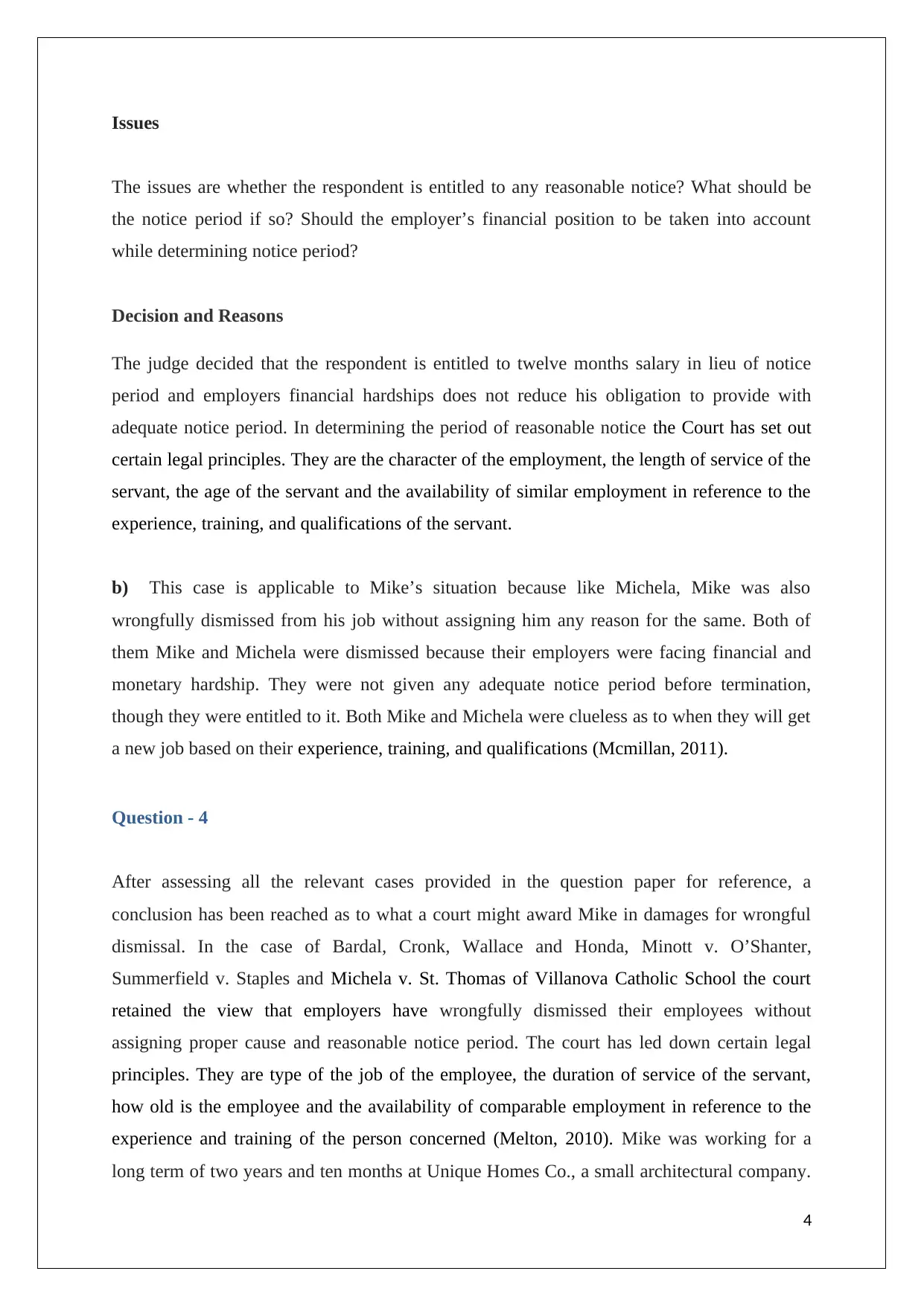
Issues
The issues are whether the respondent is entitled to any reasonable notice? What should be
the notice period if so? Should the employer’s financial position to be taken into account
while determining notice period?
Decision and Reasons
The judge decided that the respondent is entitled to twelve months salary in lieu of notice
period and employers financial hardships does not reduce his obligation to provide with
adequate notice period. In determining the period of reasonable notice the Court has set out
certain legal principles. They are the character of the employment, the length of service of the
servant, the age of the servant and the availability of similar employment in reference to the
experience, training, and qualifications of the servant.
b) This case is applicable to Mike’s situation because like Michela, Mike was also
wrongfully dismissed from his job without assigning him any reason for the same. Both of
them Mike and Michela were dismissed because their employers were facing financial and
monetary hardship. They were not given any adequate notice period before termination,
though they were entitled to it. Both Mike and Michela were clueless as to when they will get
a new job based on their experience, training, and qualifications (Mcmillan, 2011).
Question - 4
After assessing all the relevant cases provided in the question paper for reference, a
conclusion has been reached as to what a court might award Mike in damages for wrongful
dismissal. In the case of Bardal, Cronk, Wallace and Honda, Minott v. O’Shanter,
Summerfield v. Staples and Michela v. St. Thomas of Villanova Catholic School the court
retained the view that employers have wrongfully dismissed their employees without
assigning proper cause and reasonable notice period. The court has led down certain legal
principles. They are type of the job of the employee, the duration of service of the servant,
how old is the employee and the availability of comparable employment in reference to the
experience and training of the person concerned (Melton, 2010). Mike was working for a
long term of two years and ten months at Unique Homes Co., a small architectural company.
4
The issues are whether the respondent is entitled to any reasonable notice? What should be
the notice period if so? Should the employer’s financial position to be taken into account
while determining notice period?
Decision and Reasons
The judge decided that the respondent is entitled to twelve months salary in lieu of notice
period and employers financial hardships does not reduce his obligation to provide with
adequate notice period. In determining the period of reasonable notice the Court has set out
certain legal principles. They are the character of the employment, the length of service of the
servant, the age of the servant and the availability of similar employment in reference to the
experience, training, and qualifications of the servant.
b) This case is applicable to Mike’s situation because like Michela, Mike was also
wrongfully dismissed from his job without assigning him any reason for the same. Both of
them Mike and Michela were dismissed because their employers were facing financial and
monetary hardship. They were not given any adequate notice period before termination,
though they were entitled to it. Both Mike and Michela were clueless as to when they will get
a new job based on their experience, training, and qualifications (Mcmillan, 2011).
Question - 4
After assessing all the relevant cases provided in the question paper for reference, a
conclusion has been reached as to what a court might award Mike in damages for wrongful
dismissal. In the case of Bardal, Cronk, Wallace and Honda, Minott v. O’Shanter,
Summerfield v. Staples and Michela v. St. Thomas of Villanova Catholic School the court
retained the view that employers have wrongfully dismissed their employees without
assigning proper cause and reasonable notice period. The court has led down certain legal
principles. They are type of the job of the employee, the duration of service of the servant,
how old is the employee and the availability of comparable employment in reference to the
experience and training of the person concerned (Melton, 2010). Mike was working for a
long term of two years and ten months at Unique Homes Co., a small architectural company.
4
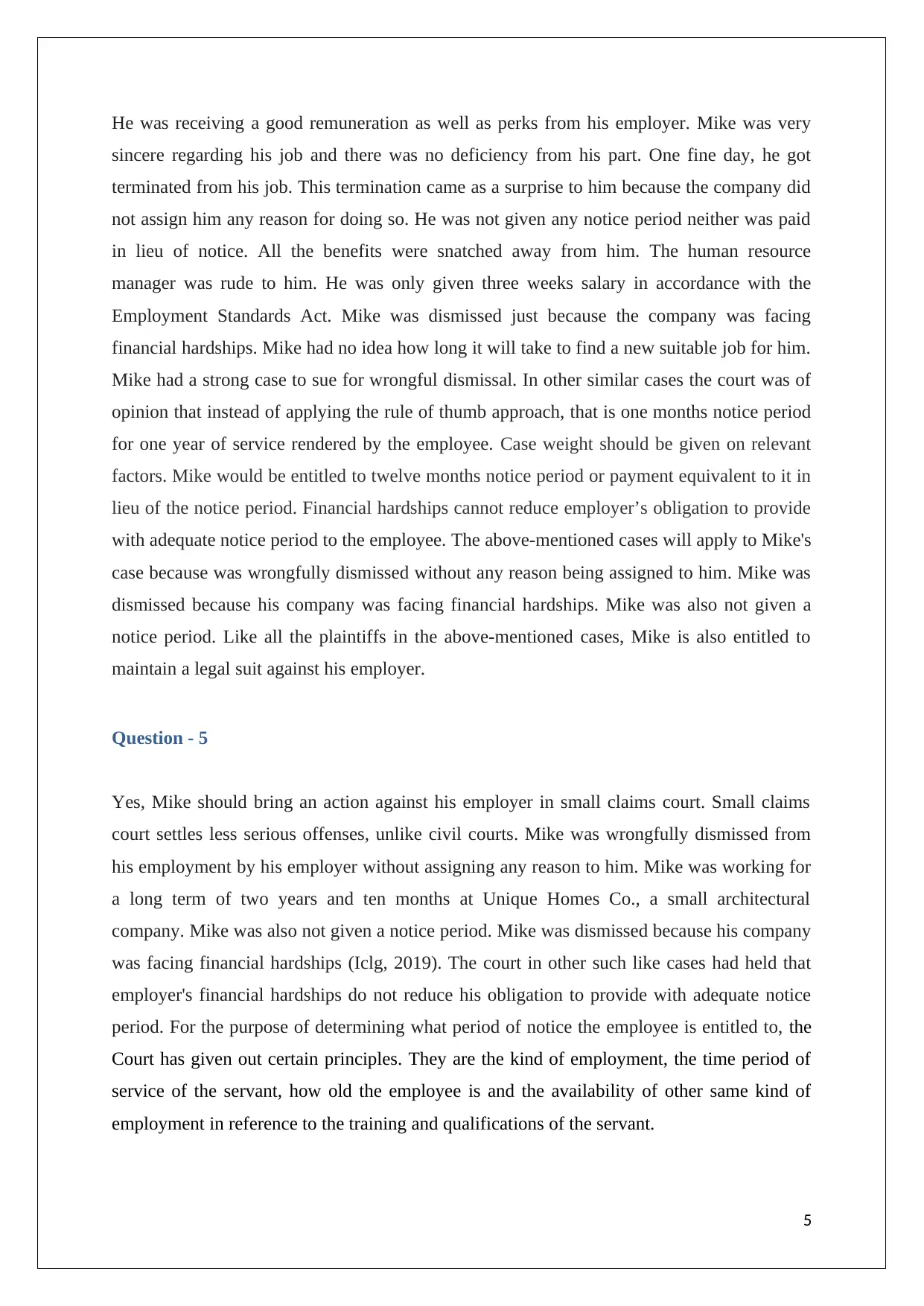
He was receiving a good remuneration as well as perks from his employer. Mike was very
sincere regarding his job and there was no deficiency from his part. One fine day, he got
terminated from his job. This termination came as a surprise to him because the company did
not assign him any reason for doing so. He was not given any notice period neither was paid
in lieu of notice. All the benefits were snatched away from him. The human resource
manager was rude to him. He was only given three weeks salary in accordance with the
Employment Standards Act. Mike was dismissed just because the company was facing
financial hardships. Mike had no idea how long it will take to find a new suitable job for him.
Mike had a strong case to sue for wrongful dismissal. In other similar cases the court was of
opinion that instead of applying the rule of thumb approach, that is one months notice period
for one year of service rendered by the employee. Case weight should be given on relevant
factors. Mike would be entitled to twelve months notice period or payment equivalent to it in
lieu of the notice period. Financial hardships cannot reduce employer’s obligation to provide
with adequate notice period to the employee. The above-mentioned cases will apply to Mike's
case because was wrongfully dismissed without any reason being assigned to him. Mike was
dismissed because his company was facing financial hardships. Mike was also not given a
notice period. Like all the plaintiffs in the above-mentioned cases, Mike is also entitled to
maintain a legal suit against his employer.
Question - 5
Yes, Mike should bring an action against his employer in small claims court. Small claims
court settles less serious offenses, unlike civil courts. Mike was wrongfully dismissed from
his employment by his employer without assigning any reason to him. Mike was working for
a long term of two years and ten months at Unique Homes Co., a small architectural
company. Mike was also not given a notice period. Mike was dismissed because his company
was facing financial hardships (Iclg, 2019). The court in other such like cases had held that
employer's financial hardships do not reduce his obligation to provide with adequate notice
period. For the purpose of determining what period of notice the employee is entitled to, the
Court has given out certain principles. They are the kind of employment, the time period of
service of the servant, how old the employee is and the availability of other same kind of
employment in reference to the training and qualifications of the servant.
5
sincere regarding his job and there was no deficiency from his part. One fine day, he got
terminated from his job. This termination came as a surprise to him because the company did
not assign him any reason for doing so. He was not given any notice period neither was paid
in lieu of notice. All the benefits were snatched away from him. The human resource
manager was rude to him. He was only given three weeks salary in accordance with the
Employment Standards Act. Mike was dismissed just because the company was facing
financial hardships. Mike had no idea how long it will take to find a new suitable job for him.
Mike had a strong case to sue for wrongful dismissal. In other similar cases the court was of
opinion that instead of applying the rule of thumb approach, that is one months notice period
for one year of service rendered by the employee. Case weight should be given on relevant
factors. Mike would be entitled to twelve months notice period or payment equivalent to it in
lieu of the notice period. Financial hardships cannot reduce employer’s obligation to provide
with adequate notice period to the employee. The above-mentioned cases will apply to Mike's
case because was wrongfully dismissed without any reason being assigned to him. Mike was
dismissed because his company was facing financial hardships. Mike was also not given a
notice period. Like all the plaintiffs in the above-mentioned cases, Mike is also entitled to
maintain a legal suit against his employer.
Question - 5
Yes, Mike should bring an action against his employer in small claims court. Small claims
court settles less serious offenses, unlike civil courts. Mike was wrongfully dismissed from
his employment by his employer without assigning any reason to him. Mike was working for
a long term of two years and ten months at Unique Homes Co., a small architectural
company. Mike was also not given a notice period. Mike was dismissed because his company
was facing financial hardships (Iclg, 2019). The court in other such like cases had held that
employer's financial hardships do not reduce his obligation to provide with adequate notice
period. For the purpose of determining what period of notice the employee is entitled to, the
Court has given out certain principles. They are the kind of employment, the time period of
service of the servant, how old the employee is and the availability of other same kind of
employment in reference to the training and qualifications of the servant.
5
⊘ This is a preview!⊘
Do you want full access?
Subscribe today to unlock all pages.

Trusted by 1+ million students worldwide
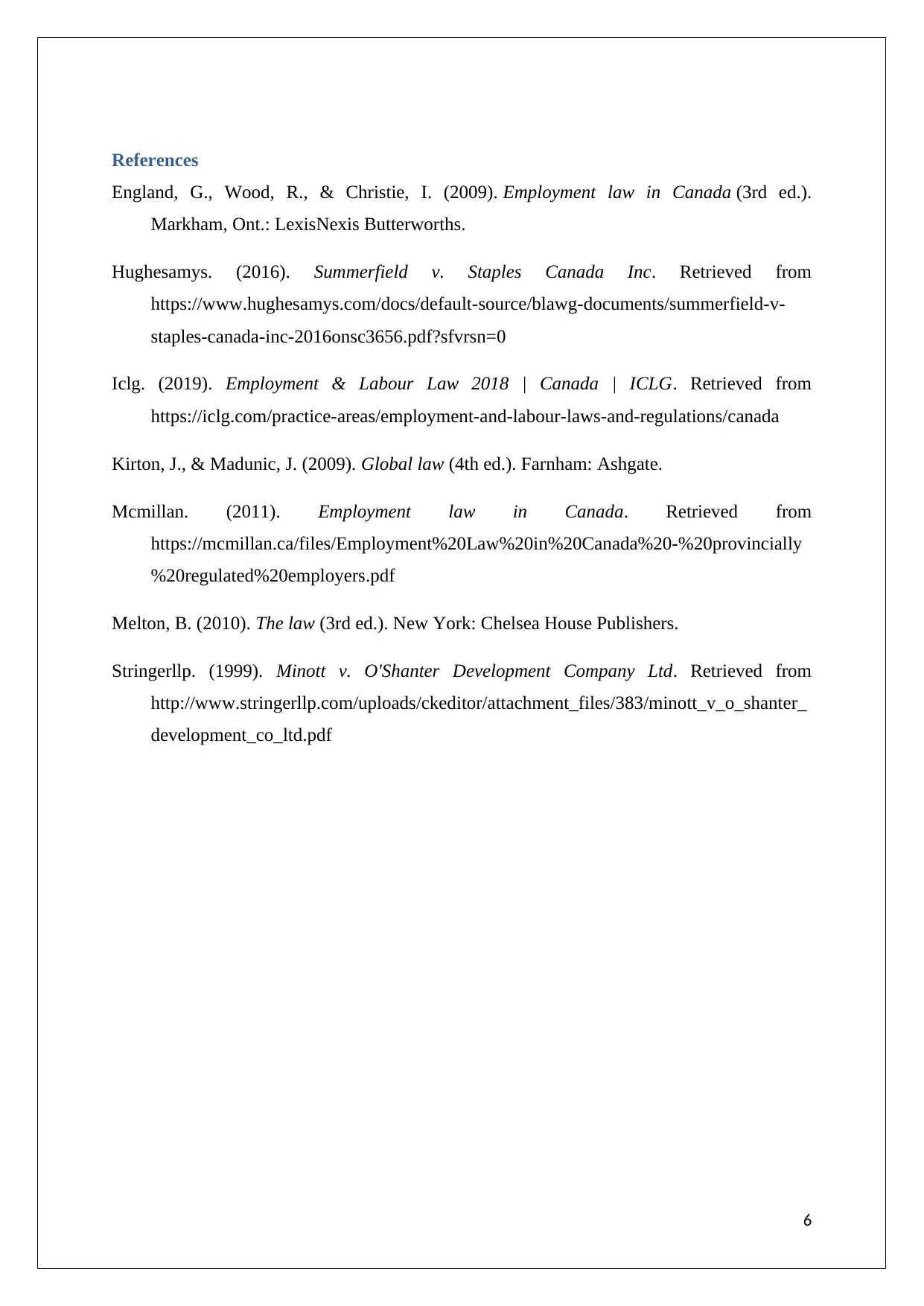
References
England, G., Wood, R., & Christie, I. (2009). Employment law in Canada (3rd ed.).
Markham, Ont.: LexisNexis Butterworths.
Hughesamys. (2016). Summerfield v. Staples Canada Inc. Retrieved from
https://www.hughesamys.com/docs/default-source/blawg-documents/summerfield-v-
staples-canada-inc-2016onsc3656.pdf?sfvrsn=0
Iclg. (2019). Employment & Labour Law 2018 | Canada | ICLG. Retrieved from
https://iclg.com/practice-areas/employment-and-labour-laws-and-regulations/canada
Kirton, J., & Madunic, J. (2009). Global law (4th ed.). Farnham: Ashgate.
Mcmillan. (2011). Employment law in Canada. Retrieved from
https://mcmillan.ca/files/Employment%20Law%20in%20Canada%20-%20provincially
%20regulated%20employers.pdf
Melton, B. (2010). The law (3rd ed.). New York: Chelsea House Publishers.
Stringerllp. (1999). Minott v. O'Shanter Development Company Ltd. Retrieved from
http://www.stringerllp.com/uploads/ckeditor/attachment_files/383/minott_v_o_shanter_
development_co_ltd.pdf
6
England, G., Wood, R., & Christie, I. (2009). Employment law in Canada (3rd ed.).
Markham, Ont.: LexisNexis Butterworths.
Hughesamys. (2016). Summerfield v. Staples Canada Inc. Retrieved from
https://www.hughesamys.com/docs/default-source/blawg-documents/summerfield-v-
staples-canada-inc-2016onsc3656.pdf?sfvrsn=0
Iclg. (2019). Employment & Labour Law 2018 | Canada | ICLG. Retrieved from
https://iclg.com/practice-areas/employment-and-labour-laws-and-regulations/canada
Kirton, J., & Madunic, J. (2009). Global law (4th ed.). Farnham: Ashgate.
Mcmillan. (2011). Employment law in Canada. Retrieved from
https://mcmillan.ca/files/Employment%20Law%20in%20Canada%20-%20provincially
%20regulated%20employers.pdf
Melton, B. (2010). The law (3rd ed.). New York: Chelsea House Publishers.
Stringerllp. (1999). Minott v. O'Shanter Development Company Ltd. Retrieved from
http://www.stringerllp.com/uploads/ckeditor/attachment_files/383/minott_v_o_shanter_
development_co_ltd.pdf
6
1 out of 7
Related Documents
Your All-in-One AI-Powered Toolkit for Academic Success.
+13062052269
info@desklib.com
Available 24*7 on WhatsApp / Email
![[object Object]](/_next/static/media/star-bottom.7253800d.svg)
Unlock your academic potential
Copyright © 2020–2025 A2Z Services. All Rights Reserved. Developed and managed by ZUCOL.





